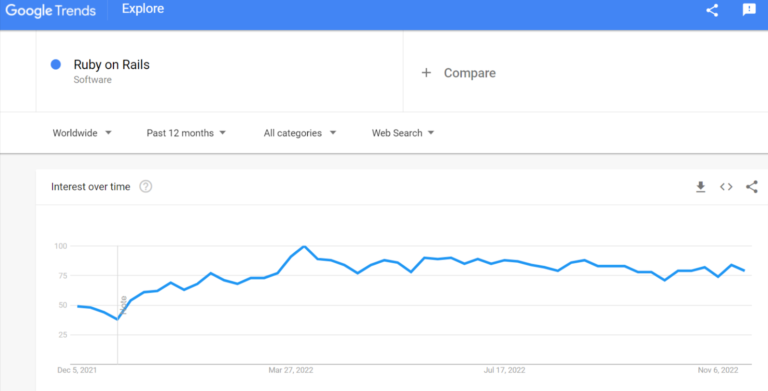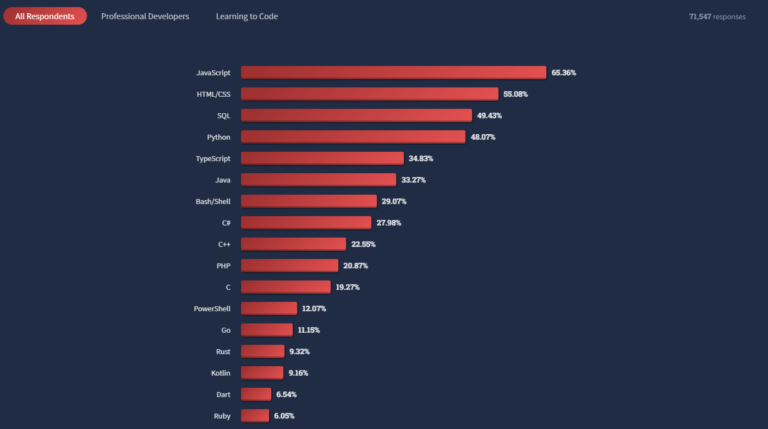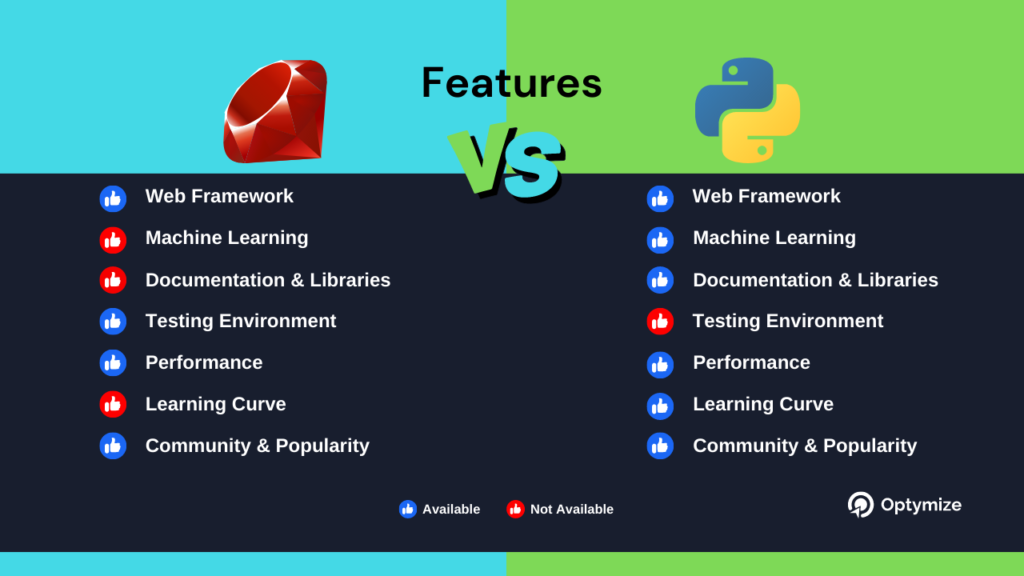Table of Contents
Introduction
Ruby Vs Python is a popular debate. They are more alike than different, and both provide clean, simple, readable, and efficient codes for backend operations.
However, they do have some differences that stand out in critical ways. And to help you understand those differences, we have put together our thoughts and experiences on each into a well-detailed article.
The Ruby Vs Python head-to-head comparison will dive deep into their differences, including their speed, readability, testing and troubleshooting, and more. So you can choose the ideal language for your product development.
The Key Differences Between Ruby Vs Python

What is Ruby?
From the very beginning, Ruby’s philosophy has always been expressiveness, classiness, and power. Ruby has always prioritized code readability so that developers can easily understand codebases.
It is a dynamic, object-oriented, open-source programming language with a focus on simplicity and productivity. It has an elegant syntax and an easy learning curve.
Ruby is used in conjunction with its framework, Ruby on Rails, which is a low-code platform that allows developers to only write fresh code. Although, apart from Ruby on Rails, there are multiple other frameworks and a few of them are the best Ruby frameworks that you can use for your Ruby web development projects.
In short, while other programming languages might need 50 lines to execute a task, Ruby on Rails only needs 10 or 15.
Though Ruby on Rails is easy to get started with, it follows its strict principles,
- Convention over configuration – for reducing configuration hassles
- DRY(don’t repeat yourself) – to code once and execute everywhere
What is Python?
The elephant in the tech industry, Python, has emerged as the most popular programming language in the world. It portrays similar traits to Ruby, but in a more advanced way.
Python was solely built to emphasize code readability with the use of significant indentations. It is a high-level general-purpose programming language that lets you work quickly and integrate systems more effectively.
Python is used with its most popular framework, Django. However, there are many Python frameworks that promise agility, much like Ruby on Rails, but Django is the one that took on the head-to-head competition with Ruby and Ruby on Rails and carried Python to a top spot as a competitive web development language. Read our blog on Ruby on Rails vs. Django to know the major differences between them.
Django is built on top of its major principles:
- DRY(don’t repeat yourself)– to code once and execute everywhere
- Explicit is better than implicit– for better readability between the user and the program
Ruby Vs Python Statistics
Statistics and popularity indices give us insights into a particular technology’s trend and how well it’s keeping up with the changing tech industry.
In addition to this, it lets you dive deep into their usability across different industries, just to ensure that you are investing in a well-versed tool.
This is why we’ve included some interesting stats on both Ruby and Python to help you understand their evolution, number of active sites, and popularity.
Why Choose Ruby?
If we take a look at the Google Trends data, it’s easy to say that Ruby is gaining traction on its popularity index. Since the end of COVID, its popularity has gone up like never before. Ruby on Rails can help you add more functionality to your services. Most of the services you use on a regular basis use some third-party API to enhance their functionality. Read our guide on how to build a Ruby on Rails API.

Moreover, according to SimilarTech, the framework of Ruby, Ruby on Rails,
- > Powers more than 410,000+ active sites on the internet.
- > Leading in the top one million+ sites and the entire web
- > Is leading in over 130+ countries.
- > Held the largest market share of 6.27% in computer electronics and technology, and over 3% in arts and entertainment, science and education, and games industry.
- Related Post: Ruby on Rails VS Node JS: An In-Depth Comparison
Why Choose Python?
Whether on Google Trends or Stack Overflow, Python dominates everywhere. Just take a look at the Stack Overflow Survey 2022. Python was able to make it into the top 5 positions as the most used and loved programming language of 2022.

However, based on the SimilarTech data Python technology:
- >Is lagging in terms of powering the top active sites in the highest ranks
- >Does hold 122,000+ active sites on the internet which is comparatively low compared to Ruby.
- >held a market share of 9% in science and education. 7% in computer electronics and technology, 2% in arts and entertainment, and 1% in the Health industry.
- Create complex web apps with the help of highly skilled and rigorously vetted Python developers and give your business a competitive edge.
Advantages and Disadvantages between Ruby vs Python
No technology is perfect, and each has its own downfalls as well as advantages. Well, you might need experienced Ruby on Rails developers to leverage the advantages of this framework. You can check out our guide to hire ROR Developers in 2023 to get some useful insights.
Let’s find out the pros and cons of Ruby and Python.
Features of Ruby
What are the Advantages of Ruby?
Shorter Development Time:
Ruby follows the principle of convention over configuration, which gives it immense speed while developing Rails applications.
The Ruby on Rails framework effectively uses low code and Ruby’s object-oriented functionality, allowing you to develop Ruby applications within a short time.
Easy Testing:
Ruby supports automated testing functionality and creates a testing skeleton as a developer writes codes, modules, and controllers.
Affordable:
With a rich talent pool of ROR developers across the planet, it’s easy to hire ROR developers from every corner of the world at an affordable price.
Tons of Library Support and Gems:
The Ruby community is huge, and over the years it has received tons of libraries and Gems. With such availability, it’s easier for developers to develop applications without wandering around looking for third-party resources. Read the top 13 Ruby on Rails Gems for your website development.
What are the Disadvantages of Ruby?
Slow Run Time:
Compared to other backend languages, Ruby has a slower run time, this is because of improper database management.
Less Flexibility:
Ruby lacks customization tools and modules that have an impact, and because of this, it is less flexible than other backend languages.
Poor Documentation:
Ruby struggles in terms of documentation of Gems, especially if it’s a lesser-known Gem. The developers have to rely on external resources and take their chances documenting everything properly.
Features of Python
What are the Advantages of Python?
Beginner Friendly
Python is easy to learn. It has an easy syntax, and it even matches local English words; hence, beginners to this language find it really enjoyable.
Extensible and Flexible
Python is extremely extensible in terms of building applications with other languages like C or C++. Developers can introduce new features using other languages, which gives them flexibility in developing any new functionality.
Vast Libraries
Python has thousands of libraries that ease a developer’s workload. These code libraries contain code for various purposes like GUI, unit testing, databases, image manipulation, etc.
Highly Scalable
Python is a highly scalable language; it is used by popular tech giants like Instagram and Pinterest for handling large traffic volumes while scaling the application from the core.
What are the Disadvantages of Python?
Design Issues
Python does have design issues, and if the developer is not experienced enough in terms of design, then it can get overwhelming to fix design issues.
Security
Python lacks security, it’s not 100% secure. To avoid any vulnerabilities, Python developers have to set up security protocols and use testing to ensure the developed application is secure.
A Bit Slower Than Compiled Languages
Python requires a lot of computational power, which slows down its performance; hence, it is a bit slower than other compiled languages.

Ruby Vs Python For Scripting
Scripting is crucial to automating tasks on websites, and both Ruby and Python support scripting functionality. Let’s take a look at how their scripting functionalities differ.
Ruby Scripting
Ruby is clean and has a much simpler type system than Python. This means developers can write scripts that don’t look like OOP because the global namespace is considered the body of the main object, which lets you implement imperative functions like print, gets, eval, etc.
Python Scripting
Python has issues while scripting; it lacks the block features that Ruby has, which make scripting a bit easier. Moreover, Python struggles with code generation and is annoying at modifying existing classes.
In addition to this, python scripts are not compiled first and then executed; rather, they are compiled every time you execute them, which leads to errors at runtime and poor performance.
Ruby Vs Python Speed
It all comes down to speed: which language is faster and can help develop applications in the shortest amount of time.
However, this criterion may not favor any language because both Ruby and Python offer nearly identical performance, so we consider this criterion to be a tie.
Ruby Vs Python Syntax Comparison
Syntax is what every beginner developer tends to look at when he wants to learn a programming language. The simpler the syntax, the simpler it is to write and comprehend code.
Both Ruby and Python have easy syntax, and beginners can use both to learn these languages in a short time and develop applications quickly. Hence this criterion is also a tie.
Ruby Vs Python Testing And Troubleshooting
Testing and troubleshooting are ways to ensure the code bases and other components of your application do not run into any errors. Let’s find out how well Ruby and Python do in terms of testing and troubleshooting.
Ruby
Ruby is well known for its automated testing and troubleshooting. In fact, as the developer writes code, its automated testing creates a skeleton.
Moreover, it supports behaviour-driven development, and this type of testing works by comparing the codebases to a list of requirements written by developers.
Python
Python lacks the behaviour-driven development that Ruby has for comparing codebases with requirements.
It does, however, support test-driven development, which finds errors as soon as code is written and enables developers to quickly fix them.
Moreover, Pytest and unit tests encourage developers to perform frequent testing for better code quality.
Ruby vs Python Applications
Every technology has its applications in specific industries. They are designed to improve the operations of particular industries and increase the flexibility of their operations. Ruby and Python both have similar as well as different applications, so let’s find out.
Applications of Ruby
- > Web development
- > DevOps
- > Automation
- > Web Scrapping
- > Data Processing
Applications of Python
- > Web development
- > Software development
- > Data Science
- > Game development
- > Machine learning
- > Artificial Intelligence
Which One to Choose: Ruby or Python? The Verdict!
Both Ruby and Python are high-level languages, and they both serve similar as well as different industries, but they don’t target the same goals, so it totally depends on your project needs.
But to give you more clarity, we have added their ideal use cases that you can take into consideration and decide which one to choose.
When to Choose Ruby?
Ruby is ideal for web application development. Even JavaScript pales in comparison to Ruby because it is much simpler and adheres to the principles of expressiveness and elegance.
That being said, Ruby has become a powerful web technology all thanks to its framework, Ruby on Rails. It lets developers develop web applications with features such as Gems, action models, Rails migration, and more. On top of this, it has an active community that is supportive and releases stable versions monthly.
So if you want to develop web applications, Ruby is the language you should choose.
When To Choose Python?
Just like Ruby, Python can be used for web applications. But it’s not as strong as Ruby in terms of web development.
It does have frameworks like Django, Flask, and others that can help you develop robust websites, but when it comes to elegance, design, and performance, Python and its frameworks are not that competitive.
However, if you decide to go for other domains like machine learning, AI, or data science, then choosing Python can be a wise choice.
Conclusion: Ruby vs Python
We have covered Ruby VS Python similarities and differences as previously stated. Both backend languages are superior at some points; however, it all depends on your project and its complexity.
If you have a project that is decent in size and you want classiness and performance to be its primary advantage, then Ruby might fulfill your needs with its rapid execution process.
However, if scalability and flexibility are all you seek in your project and you want to grow your web app on a large scale, then Python can help you with its quick scaling capabilities.







